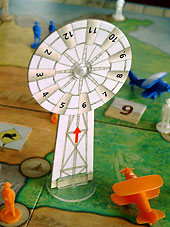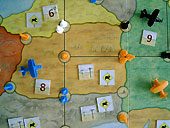Australia
page 3
| x |
|
|
|
|
|
|
|
|
|
|
|
|
|
|
|
|
|
|
|
|
|
|
|
|
|
 |
|
Players who do not shy away from a more complex game immediately can play the advanced game that in fact is not overly complex at all and could easily be incorporated in the first game already. Here is where the windmill comes in, with a scoring disk that shows initially 2, but can go to 12 points later in the game; the mill is placed in a random region on the board at the start of the game. Every time when an industry marker with a mill on it is turned face up, the wind mill moves to that region and the scoring disk is turned one number higher. A player may, when his plane is in or adjacent to the region of the wind mill, place one or more rangers next to the wind mill track instead of placing them on one of the available fields in that region. The track itself offer place for the markers of already scored regions. |
| x |
|
|
|
|
|
|
|
|
|
|
|
|
|
|
|
|
|
|
|
|
|
|
|
|
|
Whenever a region is scored for industry or wildlife, the involved marker is placed on the wind mill track. When the track is fully occupied, a score takes place with so many points to score as the disk on the wind mill indicates; the player who has the most rangers on the track scores full points, second gets half, and third half of that, rounded down. Ties are broken by a ranger higher on the track. Later in the game, when the mill has higher numbers on the disk, it is essential to get at least one of your rangers on the wind mill track to earn the points when a score takes place; twelve points to earn is no strap!
|

 |
 |
|
|
|
|
|
|
|
|
|
|
|
|
|
|
|
|
|
|
|
|
|
|
In this game by Wolfgang Kramer and Michael Kiesling it seems as if the setting of ‘El Grande’ has moved from Spain to Australia; we encounter the same elements like scores, majorities and points, where the caballeros are rangers, and the ‘grande’ has been replaced by a plane. The theme can be called extremely thin; nowhere players get the feeling that they are actually dealing with the culture of Australia. Where are the Aboriginals, the kangaroos; where is Ayers Rock or Alice Springs? Take a look at the site of Alice Springs for instance, for missed opportunities!
|
|
 |
| x |
|
|
|
|
|
|
|
|
|
|
|
|
|
|
|
|
|
|
|
|
|
|
|
|
 |
|
Through the illustration on the cover of the box you expect to encounter the heath of the continent, but inside it is an ill heated microwave dinner! The illustraion on the mapboard is of a remarkable paleness and fails to have any attraction. The drawing of the continent could have been done more advanced, with heigth differences and the occasional information about Australia. One does not need to produce a game about trains to depict town names! |
| xx |
|
|
|
|
|
|
|
|
|
|
|
|
|
|
|
|
|
|
|
|
|
|
|
|
|
| The game is easy to play; after the occasional confusion there are no difficulties. New players sometimes get confused with playing a card and flying; they think they have to pay with the card to be able to fly. |
| x |
|
|
|
|
|
|
|
|
|
|
|
|
|
|
|
|
|
|
|
|
|
|
|
|
|
| Cards luck is minimal and is further reduced by being able to change the colour of the card by paying 3 gold. However, it sometimes can be hard to get to a region where the mill is placed. Besides, when all fields are occupied with rangers from other players, you have no more chance to participate in the extra points, when the wind mill track is scored an additional time after the game has ended. Placing rangers can activate multiple scores; one for the required rangers in a region, and one for having all field in that region occupied with at least one ranger. But the adjacent regions can be affected by this placement too, and activate a scoring as well. And taking away rangers also can activate a score! |
 |
| x |
|
|
|
|
|
|
|
|
|
|
|
|
|
|
|
|
|
|
|
|
|
|
|
|
|
Despite the lack of originality we have a very playable game on our table that we can play within an hour. ‘Australia’ does not explore the outback and stays on known paths but is despite all this just enough different to play it often and with joy. Now I must go to the video store for this famous series: Skippíé! Skíppie! Skippie the búshkangaróó!
© 2005 Richard van Vugt
Australia, Wolfgang Kramer & Michael Kiesling, Ravensburger, 2005 - 2 to 5 players
|
  |
|
|
|
 |
|
|
|
|
|
|
|
|
|
|
|
|
|
|
  |
|
|
|
|
|
|
|
|
|
|
|
|
|
|
|
|
|
  |
|
|
|
|
|
|
|
|
|
|
|
|
|
|
|
|
|
  |
|
|
|
|
|
|
|
|
|
|
|
|
|
|
|
|
|
  |
|
|
|
|
|
|
|
|
|
|
|
|
|
|
|
|
|
| x |
|
|
|
|
|
|
|
|
|
|
|
|
|
|
|
|
|
|
|
|
| x |
|
|
|
|
|
|
|
|
|
|
|
|
|
|
|
|
|
|
|
|
 |
|
|
|
|
|
|
|
|
|
|
|
|
|
|
|
|
|
 |
|
|
|
|
|
|
|
|
|
|
|
|
|
|
|
|
|
 |
|
|
|
|
|
|
|
|
|
|
|
|
|
|
|
|
|
| x |
|
|
|
|
|
|
|
|
|
|
|
|
|
|
|
|
|
|
|
|
|
|
|
|
|
 |
|
|
|
|
|
|
|
|
|
|
|
|
|
|
|
|
 |
|
|
|
|
|
|
|
|
|
|
|
|
|
|
|
|
|
|